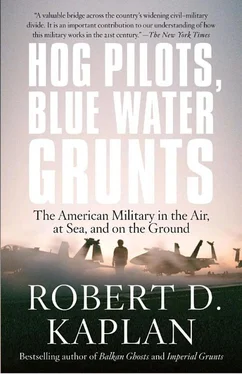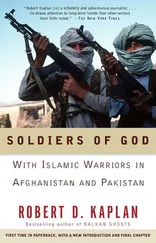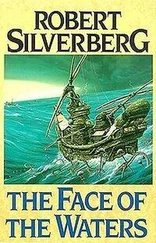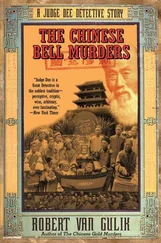The kids in such places particularly amazed the marines. Steve Long talked about a little boy he had seen in Chad working a field with a primitive implement. When Long had offered him crackers from an MRE box, the boy collected several other kids from the village, made them line up, and gave each a piece. “That’s good-to-go,” Long said. “These kids don’t need Mommy and Daddy to do things for them, it’s like rural America a hundred years ago.”
Getting stuck in the mud, we wrapped the winch around a tree. A group of young men helped out by matting the tire area with dried leaves and branches for traction. The marines gave them MREs as gifts, explaining through sign language how to use the heaters. Like the young men I had met in villages near Tondibiah, they were without jobs and complained of nothing to do. These villages would not remain traditional for long, I realized, not with jobless youth, a soaring population, democratization, and the possibility of a small-scale oil bonanza—of the kind that had ruined Nigeria. Something would happen here, good or bad. You could almost feel the ground shifting below your feet.
The training site was an immense, wadi-scarred savannah that featured a series of volcanic plugs: steep hills littered with scree. I accompanied Maj. Baker, 1st Lt. Dekryger, and Staff Sgt. Long to the top of one, from where they surveyed the area. Even at the summit the heat did not abate. The three marines barely noticed. “What an awesome tract,” Lt. Dekryger exclaimed. “There’s nothing here to impede us.” They began picking out wadis and draws where units could be concealed and lay down supporting fire. The two-mile distance between each hill created fire lines for different platoons to operate. They went on about how lucky they were to be here even if, as they told me, it wasn’t Afghanistan or Iraq. [6] Months later, I received a message from Sgt. Chris Singley—from Fallujah. Soon after he had left Niger, he got his wish: deployment to Iraq as the senior advisor to a company of the new Iraqi Army, which assisted U.S. marines and soldiers during the fighting in the second battle of Fallujah in November 2004. It was a long e-mail, telling me about the 103 Purple Hearts issued as of Christmas Eve 2004, and of the Americans and their Iraqi allies who died there. The few months he had spent in Iraq were clearly the most meaningful of his life.
TWO
ALASKA TO THAILAND: THE ORGANIZING PRINCIPLE OF THE EARTH’S SURFACE
Pacific Ocean, Autumn 2004
While the American military was building a new system of personalized, bilateral relationships with African armies, in the Pacific it was refitting a constellation of bases that had been the legacy of the Philippine War, World War II, and the Korean conflict. The object in both cases was a global footprint that was deliberately shallower on the ground, even as it was faster on the move. Witnessing its fitful emergence meant traveling from the world’s greatest desert to its greatest ocean.
Generally speaking, while Africa represented the unconventional challenges posed by anarchy and weak states, the Pacific represented the more conventional challenges posed by rising powers and rogue states.
———
As suggestive as the Pacific was of the caressing tropics, Alaska represented some of the region’s most vital military real estate. I headed there first, arriving in Anchorage at midnight, November 1, 2004. I carried a single backpack stuffed with winter gear for the coming days and summer gear for the rest of the journey. In this trip with the American military, I would be hopping planes from the Arctic Circle to the equator, and from North America to Southeast Asia. Rather than form a personal relationship with a battalion, a platoon, or a lone officer, as in my previous journeys, this time I was after a broad, ground-level view of the world’s most developing military theater.
On the Pentagon’s map of geographic “area” commands, Alaska appeared as the most interesting place on earth. While every other dry-land region was covered in one solid color, denoting which command it fell under, Alaska bore blue and green stripes: blue for NORTHCOM (Northern Command) and green for PACOM (Pacific Command). As part of mainland North America, Alaska belonged to NORTHCOM, whose mission—aligned with that of the newly created Department of Homeland Security—was to protect the continental United States from attack, particularly from incoming missiles. In reality, though, this, the largest of the fifty states, was part of PACOM. Alaska’s strategic utility as a boreal lookout and forward base against the Russian Far East, in addition to points along the Pacific Rim, could not be overestimated. Item: Alaska included the Aleutians, a chain of seventy fog-strewn and volcanic islands constituting the northern wall of the Pacific Ocean that stretched across the International Date Line to Russia’s Kamchatka Peninsula.
Formally known as “Russian North America,” Alaska had been acquired from Czar Alexander II as a result of an 1867 treaty negotiated by William Henry Seward, President Andrew Johnson’s secretary of state. Derided as “Seward’s Folly,” this territorial acquisition would turn out to be anything but that, of course. The U.S. Army opened up Alaska beginning in the last decades of the nineteenth century, putting in the roads and ports and doing the early mapping, as well as policing the territory during the unruly gold rush days. Alaska boomed in the early 1940s, when it became a base for protecting the U.S. mainland against a Japanese attack, as well as the principal node for delivering aircraft to the Soviet Union via Siberia under the Lend-Lease Act, to help Stalin fight Hitler.
The economic and emotional ties between the U.S. military and Alaska never wavered. By the early twenty-first century, one-fifth of Alaska’s population was either active-duty soldiers and airmen, members of the Reserve and National Guard, veterans who had been stationed in Alaska and decided to retire here for the hunting and fishing, or civilians who worked for the military. The Department of Defense remained the state’s main employer. In the archetypal ideological division of “red” and “blue” America, Alaska was no less “red” (Republican) than Massachusetts was “blue” (Democrat).
The Air Force loved Alaska every bit as much as the Army did. Airmen saw the state as one vast training space and make-believe war zone, featuring great distances and with relatively few low-level noise restrictions. Military pilots could do almost anything they wanted here.
“Welcome to the Banana Belt,” said Army Maj. Kirk Gohlke of Frankenmuth, Michigan, as I stepped into several inches of snow and fifteen-degree temperature outside Anchorage airport. Maj. Gohlke wasn’t kidding. Because of its proximity to the ocean, Anchorage’s climate was mild compared to much of the rest of the state. Because he had lived farther north in Alaska, Maj. Gohlke saw the state’s biggest city as a bit too temperate climatically and, perhaps, with too many sophisticated airs culturally.
I spent the first night at Fort Richardson, outside Anchorage, named for Brig. Gen. Wilds Richardson, a native Texan who had commanded troops on the Yukon River a hundred years earlier. An Army outpost, Fort Richardson was adjacent to Elmendorf Air Force Base. [7] Named after Hugh Merle Elmendorf, born in 1895 in Ithaca, New York. A pioneer in high-altitude formation flying, he died while test piloting a Y1P-25 in 1933, near Wright Field in Ohio.
This would be the pattern throughout the Pacific. The Army operated as a forward presence thanks to the Air Force, which provided the transportation lift.
Fort Richardson was headquarters for USARAK (U.S. Army, Alaska). USARAK was dominated by the 172nd Separate Infantry Brigade, which was about to become the Army’s third Stryker Brigade Combat Team. The change in nomenclature carried momentous implications. Let me explain:
Читать дальше












